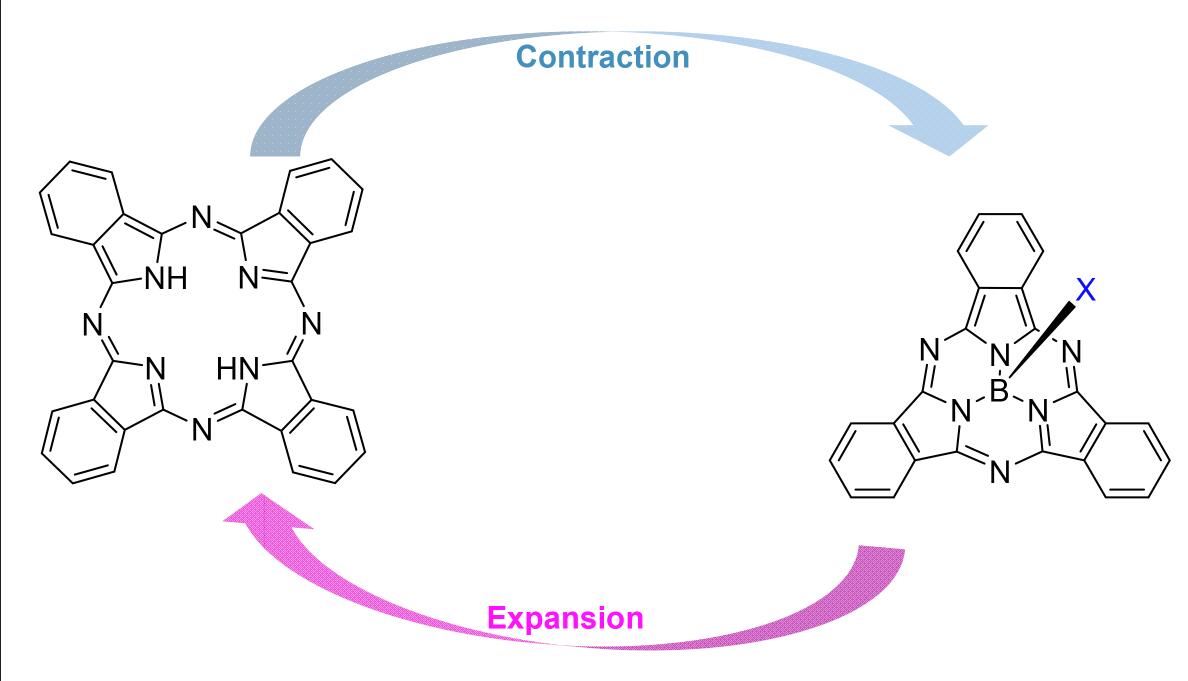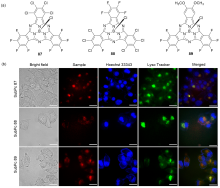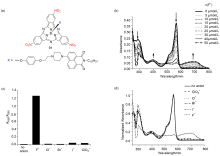有机化学 ›› 2023, Vol. 43 ›› Issue (8): 2628-2646.DOI: 10.6023/cjoc202211020 上一篇 下一篇
综述与进展
收稿日期:2022-11-16
修回日期:2023-01-27
发布日期:2023-03-30
基金资助:
Shutong Zhou, Shengnan Tu, Zijian Gao, Yemei Wang( ), Shasha Sun(
), Shasha Sun( )
)
Received:2022-11-16
Revised:2023-01-27
Published:2023-03-30
Contact:
*Supported by:文章分享

亚酞菁是酞菁缩环衍生物的典型代表, 表现出新颖的锥形结构、优异的发光性质和丰富的可调控性, 是一类有研究前景的新型荧光染料. 研究证明通过对亚酞菁轴向、外围或中心环结构的简单修饰, 可以有效调控其物理化学性质, 如溶解性、吸收/荧光发射、荧光量子产率、单线态氧产率等, 近年来引起了化学工作者的广泛关注. 介绍了亚酞菁的结构、性质和研究意义, 重点综述了亚酞菁的合成、结构和性质的关系及其在生物化学、材料化学和环境化学等领域的应用进展. 最后对亚酞菁的发展现状做了简要总结, 并对亚酞菁的发展进行了展望.
周姝彤, 涂胜男, 高子健, 王叶梅, 孙莎莎. 亚酞菁的合成、性质与应用研究进展[J]. 有机化学, 2023, 43(8): 2628-2646.
Shutong Zhou, Shengnan Tu, Zijian Gao, Yemei Wang, Shasha Sun. Research Progress in Synthesis, Properties and Application of Subphthalocyanine[J]. Chinese Journal of Organic Chemistry, 2023, 43(8): 2628-2646.






| Compound | X | λabs/nm | λem/nm |
|---|---|---|---|
| 4 | Cl | 564 | 569 |
| 52 | F | 562 | 568 |
| 53 | Br | 566 | 572 |
| 54 | | 561 | 570 |
| 55 | | 564 | 571 |
| 56 | | 567 | 575 |
| 57 | | 569 | 577 |
| 58 | | 566 | 581 |
| 59 | | 562 | 571 |
| 60 | | 563 | 592 |
| Compound | X | λabs/nm | λem/nm |
|---|---|---|---|
| 4 | Cl | 564 | 569 |
| 52 | F | 562 | 568 |
| 53 | Br | 566 | 572 |
| 54 | | 561 | 570 |
| 55 | | 564 | 571 |
| 56 | | 567 | 575 |
| 57 | | 569 | 577 |
| 58 | | 566 | 581 |
| 59 | | 562 | 571 |
| 60 | | 563 | 592 |






| [1] |
Meller, A.; Ossko, A. Monatsh. Chem. 1972, 103, 150.
doi: 10.1007/BF00912939 |
| [2] |
Rauschnabe, J.; Hanack, M. Tetrahedron Lett. 1995, 36, 1629.
doi: 10.1016/0040-4039(95)00124-U |
| [3] |
Claessens, C. G.; Gonzalez-Rodriguez, D.; Rodriguez-Morgade, M. S.; Medina, A.; Torres, T. Chem. Rev. 2014, 114, 2192.
doi: 10.1021/cr400088w |
| [4] |
Claessens, C. G.; Gonzalez-Rodriguez, D.; Torres, T. Chem. Rev. 2002, 102, 835.
doi: 10.1021/cr0101454 |
| [5] |
Liu, W.; Lee, C. H.; Li, H. W.; Lam, C. K.; Wang, J.-Z.; Mak, T. C.; Ng, D. K. P. Chem. Commun. 2002, 6, 628.
|
| [6] |
Li, D.-P.; Zhang, P.; Ge, S.-X.; Sun, G.-F.; He, Q.; Fa, W.-J.; Li, Y.; Ma, J.-T. RSC Adv. 2021, 11, 31226.
doi: 10.1039/D1RA04064B |
| [7] |
Yuan, Y.-B.; Li, H.; Jiang, Z.; Lin, Z.-C.; Tang, Y.-R.; Wang, H.-X.; Liang, Y.-Y. Chem. Sci. 2022, 13, 11260.
doi: 10.1039/D2SC03714A |
| [8] |
Poirier, M.; Pouget, J. P.; Thompson, J. A.; Hoffman, B. M. Phys. Rev. B 1995, 51, 14861.
pmid: 9978437 |
| [9] |
Zhong, H.-X.; Wang, M.-C.; Ghorbani-Asl, M.; Zhang, J.-C.; Ly, K. H.; Liao, Z.-Q.; Chen, G.-B.; Wei, Y.-D.; Biswal, B. P.; Zschech, E.; Weidinger, I. M.; Krasheninnikov, A. V.; Dong, R.-H.; Feng, X.-L. J. Am. Chem. Soc. 2021, 143, 19992.
doi: 10.1021/jacs.1c11158 |
| [10] |
Zhong, H.-X.; Ly, K. H.; Wang, M.-C.; Krupskaya, Y.; Han, X.-C.; Zhang, J.-C.; Zhang, J.; Kataev, V.; Buchner, B.; Weidinger, I. M.; Kaskel, S.; Liu, P.; Chen, M.-W.; Dong, R.-H.; Feng, X.-L. Angew. Chem., Int. Ed. Engl. 2019, 58, 10677.
doi: 10.1002/anie.v58.31 |
| [11] |
Liu, Z.-L.; Zhang, X.-J.; Zhang, H.; Jiang, H.; Zhao, X.-M.; Shi, L.; Zhu, X.-J.; Hao, X.-Q.; Song, M.-P. Chin. J. Org. Chem. 2020, 40, 2755. (in Chinese)
doi: 10.6023/cjoc202003068 |
|
( 刘子林, 张小洁, 张恒, 姜辉, 赵雪梅, 石林林, 朱新举, 郝新奇, 宋毛平, 有机化学, 2020, 40, 2755.)
doi: 10.6023/cjoc202003068 |
|
| [12] |
Yu, Z.-F.; Wang, L.-Y.; Mu, X.-J.; Chen, C.-C.; Wu, Y.-Y.; Cao, J.; Tang, Y. Angew. Chem., Int. Ed. 2021, 60, 6294.
doi: 10.1002/anie.v60.12 |
| [13] |
Boileau, N. T.; Cranston, R.; Mirka, B.; Melville, O. A.; Lessard, B. H. RSC Adv. 2019, 9, 21478.
doi: 10.1039/C9RA03648B |
| [14] |
Wu, Y.-J.; Lv, F.-H.; Kan, J.-L.; Guan, Q.; Xue, A.-Q.; Wang, Q.-B.; Li, Y.-A.; Dong, Y.-B. RSC Adv. 2020, 10, 25958.
doi: 10.1039/D0RA03898A |
| [15] |
Luo, T.-K.; Nash, G. T.; Xu, Z.-W.; Jiang, X.-M.; Liu, J.-Q.; Lin, W.-B. J. Am. Chem. Soc. 2021, 143, 13519.
doi: 10.1021/jacs.1c07379 |
| [16] |
Furuyama, T.; Sato, T.; Kobayashi, N. J. Am. Chem. Soc. 2015, 137, 13788.
doi: 10.1021/jacs.5b09853 |
| [17] |
Furuyama, T.; Ogura, Y.; Yoza, K.; Kobayashi, N. Angew. Chem., Int. Ed. 2012, 51, 11110.
doi: 10.1002/anie.201203191 |
| [18] |
Kudrevich, S.; Brasseur, N.; La Madeleine, C.; Gilbert, S.; Van Lier, J. E. J. Med. Chem. 1997, 40, 3897.
doi: 10.1021/jm9702488 pmid: 9397170 |
| [19] |
Zheng, W.; Zhao, Y.; Zhuang, W.-H.; Wu, J.-J.; Wang, F.-Z.; Li, C.-H.; Zuo, J.-L. Angew. Chem., Int. Ed. 2018, 57, 15384.
doi: 10.1002/anie.v57.47 |
| [20] |
De la Torre, G.; Bottari, G.; Torres, T. Adv. Energy Mater. 2017, 7, 1601700.
doi: 10.1002/aenm.201601700 |
| [21] |
Dubbert, J.; Hoing, A.; Riek, N.; Knauer, S. K.; Voskuhl, J. Chem. Commun. 2020, 56, 7653.
doi: 10.1039/D0CC03065A |
| [22] |
Lee, K. H.; Leem, D. S.; Castrucci, J. S.; Park, K. B.; Bulliard, X.; Kim, K. S.; Jin, Y.-W.; Lee, S.; Bender, T. P.; Park, S. Y. ACS Appl. Mater. Interfaces 2013, 5, 13089.
doi: 10.1021/am404122v |
| [23] |
Chan, H.; Wong, H. L.; Ng, M.; Poon, C. T.; Yam, V. W. J. Am. Chem. Soc. 2017, 139, 7256.
doi: 10.1021/jacs.7b00895 |
| [24] |
Gotfredsen, H.; Holmstrom, T.; Munoz, A. V.; Storm, F. E.; Tortzen, C. G.; Kadziola, A.; Mikkelsen, K. V.; Hammerich, O.; Nielsen, M. B. Org. Lett. 2018, 20, 5821.
doi: 10.1021/acs.orglett.8b02518 pmid: 30211563 |
| [25] |
Moreno-Simoni, M.; Torres, T.; de la Torre, G. Chem. Sci. 2022, 13, 9249.
doi: 10.1039/d2sc01931k pmid: 36092995 |
| [26] |
Nohr, R. S.; McCallum, C. M.; Schuchmann, H. P. J. Porphyrins Phthalocyanines 2010, 14, 271.
doi: 10.1142/S1088424610001970 |
| [27] |
Claessens, C. G.; Torres, T. Tetrahedron Lett. 2000, 41, 6361.
doi: 10.1016/S0040-4039(00)01056-X |
| [28] |
Shimizu, S.; Miura, A.; Khene, S.; Nyokong, T.; Kobayashi, N. J. Am. Chem. Soc. 2011, 133, 17322.
doi: 10.1021/ja2052667 pmid: 21981445 |
| [29] |
Wang, Y.-M.; Mori, S.; Furuta, H.; Shimizu, S. Angew. Chem., Int. Ed. 2019, 58, 10975.
doi: 10.1002/anie.v58.32 |
| [30] |
Fulford, M. V.; Lough, A. J.; Bender, T. P. Acta Crystallogr., Sect. B: Struct. Sci. 2012, 68, 636.
doi: 10.1107/S0108768112037184 |
| [31] |
Mori, S.; Ogawa, N.; Tokunaga, E.; Tsuzuki, S.; Shibata, N. Dalton Trans. 2016, 45, 908.
doi: 10.1039/C5DT04500B |
| [32] |
Guilleme, J.; Gonzalez-Rodriguez, D.; Torres, T. Angew. Chem., Int. Ed. 2011, 50, 3506.
doi: 10.1002/anie.201007240 |
| [33] |
Swarts, P. J.; Conradie, J. Inorg. Chem. 2020, 59, 7444.
doi: 10.1021/acs.inorgchem.0c00150 |
| [34] |
Morse, G. E.; Bender, T. P. Inorg. Chem. 2012, 51, 6460.
doi: 10.1021/ic2016935 |
| [35] |
Gotfredsen, H.; Jevric, M.; Broman, S. L.; Petersen, A. U.; Nielsen, M. B. J. Org. Chem. 2016, 1, 1.
doi: 10.1021/jo01230a001 |
| [36] |
Bukuroshi, E.; Petersen, A. U.; Broløs, L.; Bender, T. P.; Nielsen, M. B. Eur. J. Inorg. Chem. 2020, 36, 3481.
|
| [37] |
Ma, F.; Zhang, G.-J.; Wu, X.-M.; Qu, W.-X.; Sun, Z.; Li, X.-G.; Yin, X.-H. J. Phys. Chem. C 2022, 126, 13496.
doi: 10.1021/acs.jpcc.2c04232 |
| [38] |
Guilleme, J.; Martinez-Fernandez, L.; Corral, I.; Yanez, M.; Gonzalez-Rodriguez, D.; Torres, T. Org. Lett. 2015, 17, 4722.
doi: 10.1021/acs.orglett.5b02213 pmid: 26371719 |
| [39] |
Berna, B. B.; Platzer, B.; Wolf, M.; Lavarda, G.; Nardis, S.; Galloni, P.; Torres, T.; Guldi, D. M.; Paolesse, R. Chem 2020, 26, 13451.
|
| [40] |
Platzer, B.; Ghazal, B.; Mariñas, V.; Labella, J.; Martínez-Díaz, M. V.; Maksheed, S.; Guldi, D. M.; Torres, T. ChemPhotoChem 2022, e202200213.
|
| [41] |
Nakano, S.; Kage, Y.; Furuta, H.; Kobayashi, N.; Shimizu, S. Chem. - Eur. J. 2016, 22, 7706.
doi: 10.1002/chem.201600548 |
| [42] |
Fujishiro, R.; Sonoyama, H.; Ide, Y.; Fujimura, T.; Sasai, R.; Kaufman, N. E. M.; Zhou, Z.-H.; Vicente, M. G. H.; Ikeue, T. J. Porphyrins Phthalocyanines 2020, 24, 212.
|
| [43] |
González-Rodríguez, D.; Torres, T. Eur. J. Org. Chem. 2009, 2009, 1871.
|
| [44] |
Gonzalez-Rodriguez, D.; Martinez-Diaz, M. V.; Abel, J.; Perl, A.; Huskens, J.; Echegoyen, L.; Torres, T. Org. Lett. 2010, 12, 2970.
doi: 10.1021/ol100984d |
| [45] |
Guilleme, J.; Aragó, J.; Ortí, E.; Cavero, E.; Sierra, T.; Ortega, J.; Folcia, C. L.; Etxebarria, J.; Gonzá lez-Rodríguez, D.; Torres, T. J. Mater. Chem. C 2015, 3, 985.
doi: 10.1039/C4TC02662D |
| [46] |
Kobayashi, N.; Kondo, R.; Nakajima, S.; Osa, T. J. Am. Chem. Soc. 1990, 112, 9640.
doi: 10.1021/ja00182a034 |
| [47] |
Caballero, E.; Fernandez-Ariza, J.; Lynch, V. M.; Romero-Nieto, C.; Rodriguez-Morgade, M. S.; Sessler, J. L.; Guldi, D. M.; Torres, T. Angew. Chem., Int. Ed. 2012, 51, 11337.
doi: 10.1002/anie.201206111 |
| [48] |
Mayoral, M. J.; Guilleme, J.; Calbo, J.; Arago, J.; Aparicio, F.; Orti, E.; Torres, T.; Gonzalez-Rodriguez, D. J. Am. Chem. Soc. 2020, 142, 21017.
doi: 10.1021/jacs.0c07291 pmid: 33186011 |
| [49] |
Guilleme, J.; Mayoral, M. J.; Calbo, J.; Arago, J.; Viruela, P. M.; Orti, E.; Torres, T.; Gonzalez-Rodriguez, D. Angew. Chem., Int. Ed. 2015, 54, 2543.
doi: 10.1002/anie.201411272 |
| [50] |
Skvortsov, I. A.; Nikitin, I. A.; Lazovskiy, D. A.; Stuzhin, P. A. Dyes Pigm. 2022, 202, 110282.
doi: 10.1016/j.dyepig.2022.110282 |
| [51] |
Tejerina, L.; Martinez-Diaz, M. V.; Torres, T. Org. Lett. 2019, 21, 2908.
doi: 10.1021/acs.orglett.9b00944 pmid: 30958683 |
| [52] |
Shimizu, S.; Nakano, S.; Hosoya, T.; Kobayashi, N. Chem. Commun. 2011, 47, 316.
doi: 10.1039/C0CC01877E |
| [53] |
Stork, J. R.; Potucek, R. J.; Durfee, W. S.; Noll, B. C. Tetrahedron Lett. 1999, 40, 8055.
doi: 10.1016/S0040-4039(99)01710-4 |
| [54] |
Wang, Y.-M.; Uchihara, K.; Mori, S.; Furuta, H.; Shimizu, S. Org. Lett. 2019, 21, 3103.
doi: 10.1021/acs.orglett.9b00752 |
| [55] |
Xu, H.; Jiang, X.-J.; Chan, E. Y.; Fong, W. P.; Ng, D. K. Org. Biomol. Chem. 2007, 5, 3987.
doi: 10.1039/b712788j |
| [56] |
Kuninobu, K.; Tsutomu, I.; Makoto, H.; Yoichi, U.; Takaji, F.; Kimio, I. Bull. Chem. Soc. Jpn. 1996, 69, 2559.
doi: 10.1246/bcsj.69.2559 |
| [57] |
Paton, A. S.; Lough, A. J.; Bender, T. P. CrystEngComm 2011, 13, 3653.
doi: 10.1039/c0ce00796j |
| [58] |
Camerel, F.; Ulrich, G.; Retailleau, P.; Ziessel, R. Angew. Chem., Int. Ed. 2008, 47, 8876.
doi: 10.1002/anie.v47:46 |
| [59] |
Rodriguez-Morgade, M. S.; Claessens, C. G.; Medina, A.; Gonzalez-Rodriguez, D.; Gutierrez-Puebla, E.; Monge, A.; Alkorta, I.; Elguero, J.; Torres, T. Chem.-Eur. J. 2008, 14, 1342.
doi: 10.1002/(ISSN)1521-3765 |
| [60] |
Morse, G. E.; Castrucci, J. S.; Helander, M. G.; Lu, Z. H.; Bender, T. P. ACS Appl. Mater. Inter. 2011, 3, 3538.
doi: 10.1021/am200758w |
| [61] |
Gonzalez-Rodriguez, D.; Torres, T.; Guldi, D. M.; Rivera, J.; Herranz, M. A.; Echegoyen, L. J. Am. Chem. Soc. 2004, 126, 6301.
doi: 10.1021/ja039883v |
| [62] |
Mutolo, K. L.; Mayo, E. I.; Rand, B. P.; Forrest, S. R.; Thompson, M. E. J. Am. Chem. Soc. 2006, 128, 8108.
doi: 10.1021/ja061655o |
| [63] |
Beaumont, N.; Cho, S. W.; Sullivan, P.; Newby, D.; Smith, K. E.; Jones, T. S. Adv. Funct. Mater. 2012, 22, 561.
doi: 10.1002/adfm.201101782 |
| [64] |
Sullivan, P.; Duraud, A.; Hancox, l.; Beaumont, N.; Mirri, G.; Tucker, J. H. R.; Hatton, R. A.; Shipman, M.; Jones, T. S. Adv. Energy Mater. 2011, 1, 352.
doi: 10.1002/aenm.v1.3 |
| [65] |
Cnops, K.; Rand, B. P.; Cheyns, D.; Verreet, B.; Empl, M. A.; Heremans, P. Nat. Commun. 2014, 5, 3406.
doi: 10.1038/ncomms4406 |
| [66] |
Duan, C.-H.; Zango, G.; Garcia Iglesias, M.; Colberts, F. J.; Wienk, M. M.; Martinez-Diaz, M. V.; Janssen, R. A.; Torres, T. Angew. Chem., Int. Ed. 2017, 56, 148.
doi: 10.1002/anie.201608644 |
| [67] |
Hang, H.; Zhang, Z.-J.; Wu, X.-F.; Chen, Y.-H.; Li, H.; Wang, W.-J.; Tong, H.; Wang, L.-L. J. Mater. Chem. C 2018, 6, 7141.
doi: 10.1039/C8TC01988F |
| [68] |
Hang, H.; Wu, X.-F.; Xu, Q.; Chen, Y.-H.; Li, H.; Wang, W.-J.; Tong, H.; Wang, L.-L. Dyes Pigm. 2019, 160, 243.
doi: 10.1016/j.dyepig.2018.07.050 |
| [69] |
Huang, T.-D.; Chen, H.; Feng, J.-J.; Zhang, A.-D.; Jiang, W.; He, F.; Wang, Z.-H. ACS Mater. Lett. 2019, 1, 404.
|
| [70] |
Huang, X.-S; Hu, M.; Zhao, X.-H.; Li, C.; Yuan, Z.-Y.; Liu, X.; Cai, C.-S.; Zhang, Y.-D.; Hu, Y.; Chen, Y.-W. Org. Lett. 2019, 21, 3382.
doi: 10.1021/acs.orglett.9b01130 |
| [71] |
Jiang, D.-F.; Pan, Y.-F.; Yao, H.-Y.; Sun, J.-M.; Xiong, W.-W.; Li, L.-L.; Zheng, F.-F.; Sun, S.-S.; Zhu, J.-J. Anal. Chem. 2022, 94, 9074.
doi: 10.1021/acs.analchem.2c01308 |
| [72] |
Yao, H.-Y.; Jiang, D.-F.; Dong, G.-Q.; Sun, J.-M.; Sun, S.-S.; Li, L.-L.; Zheng, F.-F.; Xiong, W.-W. Analyst 2021, 146, 5115.
doi: 10.1039/D1AN00839K |
| [73] |
Winckel, E.; Mascaraque, M.; Zamarrón, A.; Juarranz de la Fuente, Á.; Torres, T.; Escosura, A. Adv. Funct. Mater. 2018, 28, 1705938.
doi: 10.1002/adfm.v28.24 |
| [74] |
Demuth, J.; Gallego, L.; Kozlikova, M.; Machacek, M.; Kucera, R.; Torres, T.; Martinez-Diaz, M. V.; Novakova, V. J. Med. Chem. 2021, 64, 17436.
doi: 10.1021/acs.jmedchem.1c01584 pmid: 34813305 |
| [75] |
Casellas, N. M.; Dai, G.; Xue, E. Y.; Fonseca, A.; Ng, D. K. P.; Garcia-Iglesias, M.; Torres, T. Chem. Commun. 2022, 58, 669.
doi: 10.1039/D1CC05977G |
| [76] |
Zhou, S.-T.; Lv, X.-J.; Li, M.-H.; Gao, Z.-J.; Tu, S.-N.; Qiao, S.-S.; Mo, M.-J.; Tang. X.; Wang, Y.-M.; Sun, S.-S. Molecules 2023, 28, 725.
doi: 10.3390/molecules28020725 |
| [77] |
Bernhard, Y.; Winckler, P.; Chassagnon, R.; Richard, P.; Gigot, E.; Perrier-Cornet, J. M.; Decreau, R. A. Chem. Commun. 2014, 50, 13975.
doi: 10.1039/C4CC05503A |
| [78] |
Roy, I.; Shetty, D.; Hota, R.; Baek, K.; Kim, J.; Kim, C.; Kappert, S.; Kim, K. Angew. Chem., Int. Ed. Engl. 2015, 54, 15152.
doi: 10.1002/anie.201507140 |
| [79] |
Ros-Lis, J. V.; Martinez-Manez, R.; Soto, J. Chem. Commun. 2005, 42, 5260.
|
| [80] |
Li, Y.; Xu, S.; Li, X.; Chen, K.-C.; Tian, H. Chem. Lett. 2007, 36, 664.
doi: 10.1246/cl.2007.664 |
| [81] |
Arockiam, J. B.; Park, J. S. Spectrochim. Acta, Part A 2019, 207, 112.
doi: 10.1016/j.saa.2018.09.010 |
| [1] | 佘春艳, 王安静, 刘珊, 舒文明, 余维初. 芳乙酰叠氮的制备及其在有机合成中的应用进展[J]. 有机化学, 2024, 44(2): 481-507. |
| [2] | 田雁, 董睿, 聂鹏, 许波. 含不同取代基的钌-锗化合物的合成及表征[J]. 有机化学, 2024, 44(1): 173-179. |
| [3] | 徐光利, 许静, 徐海东, 崔香, 舒兴中. 过渡金属催化烯烃和炔烃合成1,3-共轭二烯化合物研究进展[J]. 有机化学, 2023, 43(6): 1899-1933. |
| [4] | 杨亮茹, 郭梦丽, 袁金伟, 王佳美, 夏宇婷, 肖咏梅, 毛璞. 钳形氮杂环卡宾金属络合物的研究进展[J]. 有机化学, 2023, 43(6): 2002-2025. |
| [5] | 钟玉梅, 邹小颖, 卓小丫, 王逸涵, 申佳奕, 郑绿茵, 郭维. 4-氧代-2-亚胺基噻唑烷-5-亚基乙酸乙酯类化合物的设计、合成及抗癌活性[J]. 有机化学, 2023, 43(4): 1452-1461. |
| [6] | 王启帆, 张源泉, 幸丽, 周远香, 龚晨裕, 何帮灿, 张念, 吴拥军, 薛伟. 含1,2,4-三唑并[3,4-b]-1,3,4-噻二唑杨梅素衍生物的设计、合成及生物活性研究[J]. 有机化学, 2023, 43(4): 1525-1536. |
| [7] | 宁德生, 符毓夏, 李连春, 邹芷琪, 潘争红. 地枫皮中一个新的单萜杂合苯丙素成分[J]. 有机化学, 2023, 43(4): 1591-1595. |
| [8] | 肖丽娟, 张艳平, 洪缪. 路易斯酸碱对在材料化学应用中的研究进展[J]. 有机化学, 2023, 43(3): 949-960. |
| [9] | 李兴军, 王江, 柳红. 丹参脂溶性成分结构优化研究进展[J]. 有机化学, 2023, 43(2): 471-490. |
| [10] | 王静, 吴琳琳, 王倩. 新型茚并芴-6,12-二酮衍生物的合成与性能研究[J]. 有机化学, 2023, 43(1): 223-228. |
| [11] | 李阳阳, 孙小飞, 胡晓玲, 任源远, 钟克利, 燕小梅, 汤立军. 三苯胺衍生物的合成及其基于聚集诱导发光(AIE)机理对汞离子“OFF-ON”荧光识别[J]. 有机化学, 2023, 43(1): 320-325. |
| [12] | 陈嘉麟, 马郅蘅, 李禹沣, 曹思炜, 庄强. 金属-多孔有机分子笼纳米复合物的研究进展[J]. 有机化学, 2023, 43(1): 120-129. |
| [13] | 葛天鹏, 杨彦辰, 李淳朴, 张剑, 柳红. 盘状结构域受体1 (DDR1)激酶抑制剂的研究进展[J]. 有机化学, 2022, 42(9): 2760-2773. |
| [14] | 李响, 张依凡, 陆凯琳, 刘石惠, 张永强. 基于莪术醇胺氟化结构修饰的三维天然产物片段库的构建[J]. 有机化学, 2022, 42(7): 2124-2133. |
| [15] | 鞠立鑫, 邵琦, 陆临川, 陆鸿飞. 基于嘌呤席夫碱荧光探针检测Al3+及细胞实验应用[J]. 有机化学, 2022, 42(6): 1706-1712. |
| 阅读次数 | ||||||
|
全文 |
|
|||||
|
摘要 |
|
|||||